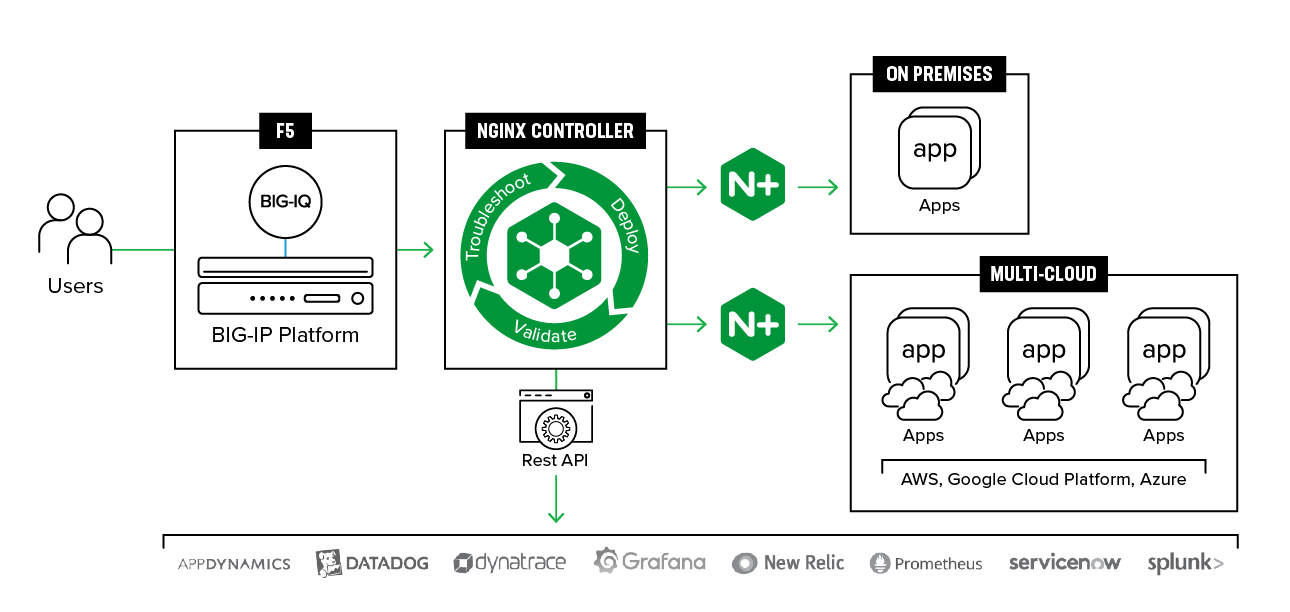Erzielen Sie Multi-Cloud-Vielseitigkeit mit Software-Load-Balancing, das für Cloud-native Apps entwickelt wurde
Mit der Cloud-nativen ADC-Lösung NGINX von F5 können Unternehmen konsistente Sicherheits- und Verkehrsmanagementrichtlinien über alle Clouds hinweg aufrechtzuerhalten.
52 % der Unternehmen ändern die Art und Weise, wie sie Anwendungen entwickeln, um die digitale Transformation zu unterstützen1, und eine Multi-Cloud-Strategie spielt dabei oft eine große Rolle. Angesichts der Flexibilität, für jede Anwendung die richtige Cloud auswählen zu können, ist es für viele Unternehmen einfach nicht mehr praktikabel, an eine Cloud gebunden zu sein.
Mit dem Wachstum Ihres App-Portfolios nehmen jedoch auch die Sicherheitsbedrohungen und Leistungsrisiken zu. Je verteilter Ihre Anwendungen werden, desto anspruchsvoller und komplexer ist die Verwaltung konsistenter Leistungs- und Lastausgleichsrichtlinien über alle Clouds hinweg.
Um der Ausbreitung von Richtlinien entgegenzuwirken, ohne die Flexibilität oder Geschwindigkeit zu beeinträchtigen, benötigen Sie eine einfache, Cloud-übergreifende Lösung zur Richtlinienverwaltung. Das bedeutet in manchen Fällen, dass man sich bewusst dafür entscheidet, die nativen Anwendungsdienste, die in den meisten öffentlichen Clouds verfügbar sind, nicht zu übernehmen. Obwohl diese Lösungen zunächst als die einfachste Option erscheinen, fehlen ihnen die erweiterten Funktionen und Cross-Cloud-Fähigkeiten, die eine Drittanbieterlösung bietet.
Mit der richtigen Lösung zur Richtlinienverwaltung erreichen Sie:
- App-Entwicklungsteams haben die Möglichkeit, für jede Anwendung die richtige Umgebung zum Hosten auszuwählen
- Netzwerk- und Sicherheitsteams haben die Möglichkeit, kritische Sicherheits- und Verkehrsmanagementrichtlinien für alle Anwendungen einheitlich zu definieren und durchzusetzen.
Der NGINX-Controller von F5 ist ein echter Software-Load Balancer, der sowohl leicht als auch flexibel ist. Der NGINX-Load Balancer, der sich problemlos in Ihre vorhandene Automatisierungs-Toolchain integrieren lässt, bietet eine Control-Plane-Lösung zum Definieren und Verwalten von Konfigurations-Workloads für Ihre NGINX-Load Balancer. Mit diesem Ansatz können Ihre Teams konsistente Sicherheits- und Leistungsrichtlinien für alle Cloud-Plattformen erstellen und bereitstellen.
Über eine intuitive grafische Benutzeroberfläche ermöglicht Ihnen NGINX Controller Folgendes:
- Definieren von Konfigurationsrichtlinien
- Wiederverwenden von Richtlinien in unterschiedlichen Umgebungen
- Stellen Sie die Einhaltung Ihrer Richtlinien sicher
- Kehren Sie jederzeit zu einer „goldenen Version“ zurück, falls Sie auf ein Problem stoßen
Die folgende Architektur veranschaulicht, dass zwei besser sind als eins: Die BIG-IP-Plattform am Edge bietet Sicherheit, Entschlüsselung und Beschleunigung mit hoher Kapazität in einem konsolidierten Multi-Tenant-Footprint, der von BIG-IQ verwaltet wird. Näher an den Anwendungen stellt NGINX Plus dedizierte Lastausgleichsdienste für einzelne Mandanten für jede vom NGINX-Controller verwaltete App bereit.

Herausforderung
Die meisten Organisationen legen mehr Wert auf die Flexibilität der Cloud und überlassen den Anwendungsteams die Auswahl der jeweils besten Umgebung für die jeweilige Anwendung als auf die organisatorischen Vorteile gemeinsamer Umgebungen, Prozesse und Tools. Dies führt dazu, dass 87 % der Unternehmen mehrere Clouds unterstützen und die jeweils besten Funktionen jeder Plattform auswählen.
Angesichts der zunehmenden Zahl von Anwendungen wird es immer schwieriger, konsistente Cloud-übergreifende Sicherheit, die Einhaltung gesetzlicher Vorschriften und Richtlinien zur Anwendungsleistung zu implementieren. Unternehmen machen sich zu Recht Sorgen um die langfristige Funktionsfähigkeit. Tatsächlich wächst mit der Größe des Anwendungsportfolios auch die Bedrohungslandschaft: Kriminelle zielen auf scheinbar unbedeutende Anwendungen ab, die zwar schlecht geschützt sind, aber einen Weg in Unternehmensdaten und andere Systeme bieten.
Lösung
Um die Komplexität zu reduzieren und die Kosten zu kontrollieren, können Sie zentrale Anwendungsdienste (z. B. Verkehrsmanagement, Anwendungssicherheit) in allen Cloud-Umgebungen standardisieren. Durch die Verwendung derselben Software-Lastausgleichslösung über mehrere Clouds hinweg erreichen Sie Vorhersehbarkeit bei den Kosten sowie Konsistenz bei der App-Leistung.
Bei einem richtlinienbasierten Ansatz für den Lastenausgleich werden Leistungs- und Sicherheitsrichtlinien pro App oder pro Mandant angewendet. Diese anwendungsspezifischen Richtlinien können dann in jeder Cloud-Umgebung sowie in jeder Bereitstellungsumgebung, z. B. in der Entwicklung und Produktion, verbreitet werden, wodurch Leistungsunregelmäßigkeiten vermieden werden.
Erfahren Sie mehr über das Lastausgleichsmodul des NGINX-Controllers. Lesen Sie das Datenblatt .
Komponenten
Die Cloud-native ADC-Lösung NGINX von F5 wurde für in der Cloud erstellte und entwickelte Anwendungen entwickelt und ist ein leichter, flexibler Software-Load Balancer, der hohe Leistung und Multi-Cloud-Vielseitigkeit bietet.
- NGINX-Controller
NGINX Controller ist die Control-Plane-Lösung von NGINX, die die NGINX-Datenebene verwaltet. NGINX Controller basiert auf einer modularen Architektur und ermöglicht Ihnen die Verwaltung des gesamten Lebenszyklus von NGINX Plus, unabhängig davon, ob es als Load Balancer, API-Gateway oder Proxy in einer Service-Mesh-Umgebung eingesetzt wird. Das Lastausgleichsmodul konfiguriert, validiert und behebt Probleme Ihrer NGINX-Lastausgleichsmodule. Mit dem API-Verwaltungsmodul können Sie APIs definieren, veröffentlichen, sichern, überwachen und analysieren.
NGINX-Controller ›
Abschluss
Multi-Cloud wird bleiben. Wenn Sie den Nutzen maximieren und die Risiken minimieren möchten, benötigen Sie eine Cloud-native ADC-Lösung, um konsistente, qualitativ hochwertige Anwendungsleistung und Sicherheitsdienste an allen Ihren privaten und öffentlichen Cloud-Standorten bereitzustellen. F5 und NGINX helfen Ihnen dabei.
Erfahren Sie mehr über NGINX Controller, indem Sie diesen Blog lesen.
Beschleunigen Sie die digitale Transformation
Erfahren Sie, wie NGINX Ihnen dabei helfen kann, Ihre zugrunde liegende IT zu modernisieren und auf einen Microservices-Ansatz umzusteigen.
Blog lesen ›
Verschaffen Sie sich einen Überblick über NGINX
Sehen Sie sich das Video an, um einen kurzen Überblick über die Überwachungs- und Warnfunktionen des NGINX Controllers zu erhalten.
Video ansehen ›
Finden Sie praktische Lösungen
Laden Sie das kostenlose E-Book von O’Reilly herunter, um einen praktischen Leitfaden zu Lastausgleichsdiensten in der Cloud zu erhalten.
E-Book herunterladen ›
1 Bericht zum Stand der Anwendungsdienste, DevOps-Ausgabe, 2019